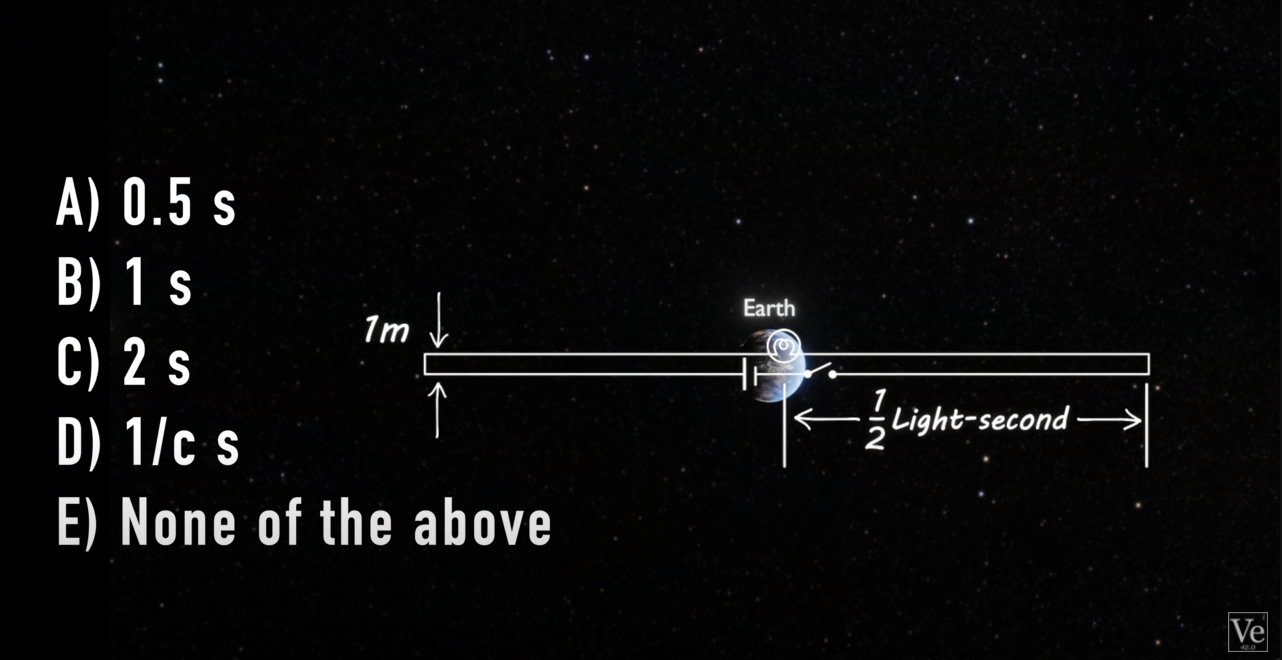Post History
The premise In a recent video by the pop-sci channel Veritasium, the concept of the flow of electricity and energy transmission in a circuit was discussed. In that video a thought experiment is pr...
#2: Post edited
- <h3>The premise</h3>
- In a [recent video](https://www.youtube.com/watch?v=bHIhgxav9LY) by the pop-sci channel Veritasium, the concept of the flow of electricity and energy transmission in a circuit was discussed. In that video a thought experiment is presented:
- 
The video concludes that, after the switch is flipped, the lightbulb will turn on after 1/c seconds, since the lamp and the battery are 1 meter apart. This is explained by showing that, in an electrical circuit, energy is transmitted through an EM field, which propagates at the speed of light, and not through movement of particles in a conductor.- This explanation did not sit right with me, for mainly two reasons:
- <ol>
- <li> Clearly, the conductor plays a role in the transmission of energy. This is actually pointed out in the video as well, by saying that after a connection in a circuit is made, the EM field will propagate along the conductor at the speed of light. To me, this would mean that the field would take 1s to propagate through the cables in the thought experiment, and the lamp will turn on after 1s.
- <li> For the lamp to turn on, current must flow through it, heating the filament. Simply being in an EM field generated by the battery would not work, there needs to be some potential difference at the lamp's terminals. The signal doesn't "know" what happens at the load until it reaches it. This is a big part of reflection in signal and transmission lines, yet seems to be ignored here. Therefore, the voltage will take 1s to arrive at the lamp in this case.
- </ol>
- <h3>The question</h3>
- Is the answer of 1/c seconds correct, or should the answer be something else? If the answer is not 1/c, where does the mistake in the video's reasoning lie?
- <h3>The premise</h3>
- In a [recent video](https://www.youtube.com/watch?v=bHIhgxav9LY) by the pop-sci channel Veritasium, the concept of the flow of electricity and energy transmission in a circuit was discussed. In that video a thought experiment is presented:
- 
- The video concludes that, after the switch is flipped, the lightbulb will turn on after 1/c seconds (1 meter divided by the speed of light), since the lamp and the battery are 1 meter apart. This is explained by showing that, in an electrical circuit, energy is transmitted through an EM field, which propagates at the speed of light, and not through movement of particles in a conductor.
- This explanation did not sit right with me, for mainly two reasons:
- <ol>
- <li> Clearly, the conductor plays a role in the transmission of energy. This is actually pointed out in the video as well, by saying that after a connection in a circuit is made, the EM field will propagate along the conductor at the speed of light. To me, this would mean that the field would take 1s to propagate through the cables in the thought experiment, and the lamp will turn on after 1s.
- <li> For the lamp to turn on, current must flow through it, heating the filament. Simply being in an EM field generated by the battery would not work, there needs to be some potential difference at the lamp's terminals. The signal doesn't "know" what happens at the load until it reaches it. This is a big part of reflection in signal and transmission lines, yet seems to be ignored here. Therefore, the voltage will take 1s to arrive at the lamp in this case.
- </ol>
- <h3>The question</h3>
- Is the answer of 1/c seconds correct, or should the answer be something else? If the answer is not 1/c, where does the mistake in the video's reasoning lie?
#1: Initial revision
How long does it take for energy to propagate in a circuit?
<h3>The premise</h3> In a [recent video](https://www.youtube.com/watch?v=bHIhgxav9LY) by the pop-sci channel Veritasium, the concept of the flow of electricity and energy transmission in a circuit was discussed. In that video a thought experiment is presented:  The video concludes that, after the switch is flipped, the lightbulb will turn on after 1/c seconds, since the lamp and the battery are 1 meter apart. This is explained by showing that, in an electrical circuit, energy is transmitted through an EM field, which propagates at the speed of light, and not through movement of particles in a conductor. This explanation did not sit right with me, for mainly two reasons: <ol> <li> Clearly, the conductor plays a role in the transmission of energy. This is actually pointed out in the video as well, by saying that after a connection in a circuit is made, the EM field will propagate along the conductor at the speed of light. To me, this would mean that the field would take 1s to propagate through the cables in the thought experiment, and the lamp will turn on after 1s. <li> For the lamp to turn on, current must flow through it, heating the filament. Simply being in an EM field generated by the battery would not work, there needs to be some potential difference at the lamp's terminals. The signal doesn't "know" what happens at the load until it reaches it. This is a big part of reflection in signal and transmission lines, yet seems to be ignored here. Therefore, the voltage will take 1s to arrive at the lamp in this case. </ol> <h3>The question</h3> Is the answer of 1/c seconds correct, or should the answer be something else? If the answer is not 1/c, where does the mistake in the video's reasoning lie?


















